
Original Link: https://www.anandtech.com/show/1739
AnandTech Exclusive: CrossFire Benchmarks Revealed
by Derek Wilson on July 22, 2005 6:00 AM EST- Posted in
- GPUs
Introduction
This week, we were very lucky to get our hands on a CrossFire motherboard and a CrossFire master card from Gigabyte.We have previously covered CrossFire, so please check out that article for more details. It all comes down to ATI's answer to SLI in the form of a master/slave card combination where the master card reconstructs the data produced by both cards and outputs it to the display. Communication between cards is done over PCI Express and a dongle that plugs into the slave card's DVI port. And today, we have the pleasure of talking about performance.
While we did get the chance to take an early look at CrossFire during Computex, we recently learned that what we saw wasn't actually full CrossFire. This time, we have an actual master card in our hands and we'll put ATI's answer to SLI to the test. Of course, due to the very prerelease nature of these products, our tests were not without some bumps and detours.
We had some trouble getting CrossFire set up and running due to a combination of factors. The first monitor that we tested doesn't work on the master card dongle with drivers installed. We weren't exactly sure in which slot the master card needed to be (we hear that it shouldn't make a difference when the final product is released), and we didn't know into which DVI port on the slave card to plug the dongle. After a bout of musical monitors, slots, and ports that finally resulted in a functional setup, we still needed to spend some time actually wrestling the driver into submission.
After getting the driver issues squared away, we got down to testing. Our first disappointment came along when we realized that the CrossFire AA modes were not quite finished. Enabling these modes drops performance much more than what we would expect and looks like the frames that each GPU renders are out of sync with the other card. We can't be totally sure what's going on here, but it's clear that there still needs to be some work done.
One thing that works well right now is SuperTiling. Except for some random display corruption when switching modes, SuperTiling looked alright and ran with good speed.
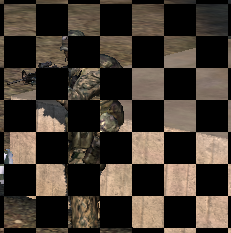
Note that each GPU will render 32x32 pixel blocks (256 adjacent quads for those keeping track).
The only random quirk that we would expect to find in prerelease hardware, which ended up getting in our way, is the fact that setting standard AA modes in the control center didn't seem to actually enable antialiasing. Games that made use of in game AA adjustments seemed to work well. Not being able to use a good CRT monitor, we had to resort to our 1600x1200 LCD for testing, limiting our max resolution. Below 16x12, many games are not GPU limited under CrossFire. Even at 16x12 with no AA, we see some games that could be pushed much further.
This brings up a point that we will be making more and more as GPUs continue to gain power. Large LCDs are very expensive and CRTs are on their way out. Buying more than one 6800 Ultra, and soon adding a CrossFire master to an X850, doesn't make much sense without being able to run more than 1280x1024. And we would really recommend being able to run at least 1600x1200 for these kinds of setups.
Let's take a closer look at the setup before we get to benchmarks.
The System
The GA-K8AMVP Pro is based on the ATI's latest RD480 chipset paired with a ULi south bridge and features CrossFire support. We'll be taking a closer look at this board as well, as Gigabyte tells us that it can even support 2x 3D1 cards. The board looks very similar to Gigabyte's NF4 SLI boards, including the selector paddle for configuring the PCI Express ports. Flipped to single GPU, the first PCI Express slot gets 16 lanes, and flipped to multi GPU mode will run each slot at x8.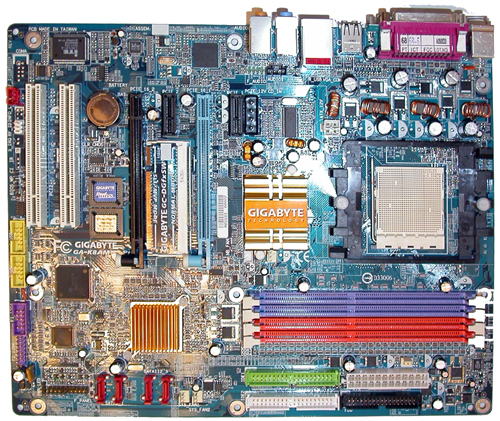
The board itself is stable and runs well. We had no problems with the platform while running our tests, and performance seems to be very solid. On this board, the master card had to be plugged into the slot closest to the CPU.
Our CrossFire master card looked very similar to a regular X850 XT. The port furthest from the motherboard connects to the dongle, which plugs into the monitor as well as the port closest to the motherboard on the slave card.
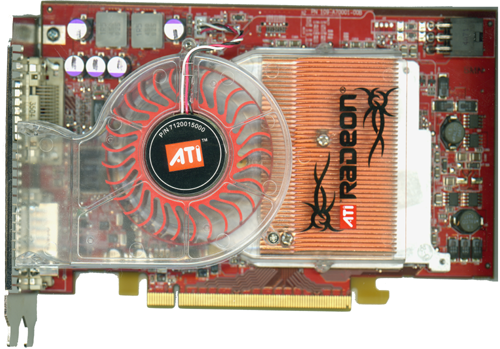
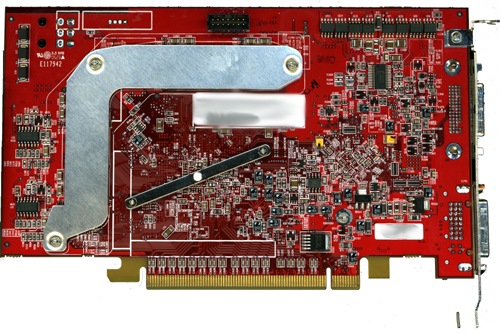
The card really does look a lot like a normal X850 XT, but we can see that the solder points for the Rage Theater chip are missing and there are quite a few components on the board in its place. All this circuitry (along with a couple of surface-mount LEDs) is likely part of the hardware needed to combine the output of both cards for final display. NVIDIA's parts don't need quite as many additional board components, as the GPU has die space committed to multi-chip rendering and all the work is done on the GPU and in the frame buffers.
That's not to say that ATI's solution is less adequate. Since the DVI port is inherently digital, the external dongle does nothing to lower image quality like the old analog dongle that 3dfx used to employ for SLI.
Before we get to the benchmarks, we will note again that with the early hardware and drivers, we had some trouble with some of the games and settings that we wanted to run. We tested most of the games that we ran in our recent 7800 launch article, but we ended up seeing numbers that didn't make sense. We don't have any reason to think that these problems will remain when the product launches, but it does shorten the list of games that we felt gave a good indication of CrossFire's performance.
For our tests, we used numbers from our original 7800 GTX review. The system (except for the motherboard) is the same as the setup used in the 7800 review (FX-55, 1GB 2:2:2 DDR400, 600W PSU, 120GB HD).
And what are our results? Take a look.
Doom 3 Performance
For Doom 3, we see CrossFire outperforming the 7800 GTX and coming close to NVIDIA 6800 Ultra SLI performance. The OpenGL foundation of Id's Doom 3 is generally handled better by NVIDIA's parts, and Doom 3 in particular makes heavy use of shadow algorithms that tend to favor NVIDIA as well. All this adds up to mean that CrossFire has shown some very solid performance in our first benchmark.While the increase in performance isn't quite double, the performance increase from a single X850 XT to CrossFire is up 43% as opposed to SLI's benefit of 34% over a single card. This is very impressive indeed. It may be that the higher single card performance of the NVIDIA part means that it has less room to improve, but no matter what the reason, this first test instantly legitimizes CrossFire as a real SLI competitor. ATI definitely has something to smile about here.
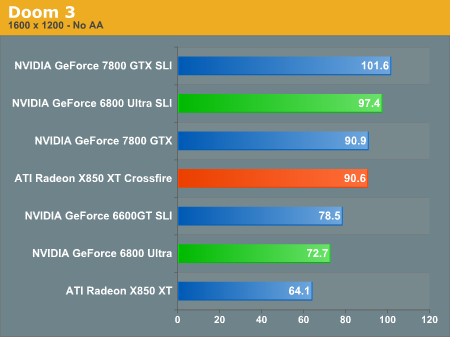
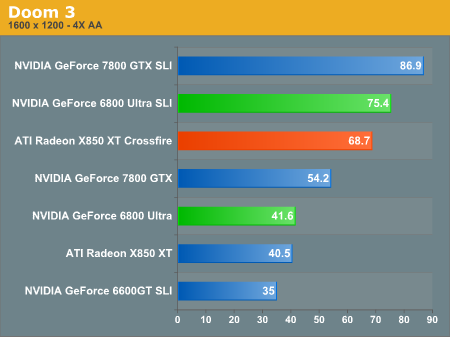
Everquest 2 Performance
Unfortunately, this is one of the games that we couldn't get AA working at all. Our test with AA shows performance to be very high, but the benefit here is small indeed. It seems that the upper limit of performance under the "Very High Quality" setting around mid-day Everquest time is near 45 frames per second at 1600x1200. We did test Extreme Quality and reached a good 9 to 12 fps on CrossFire.With AA on in combination with Very High Quality, Everquest 2 looks great, and when ATI fixes whatever issues that are going on here, it's clear that CrossFire will bring excellent performance to EQ2 addicts.
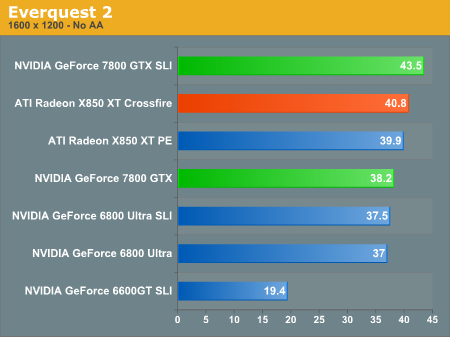
Far Cry 1.3 Performance
We didn't test Far Cry during our 7800 GTX evaluation, but our CrossFire tests showed this game to respond really well. We didn't want to leave it out, as this is one of the few games that we could test both with and without AA. We also get a glimpse at the full potential of CrossFire.Nearly a 2x increase in performance over the single X850, Far Cry benefits from CrossFire more than any other game that we tested.
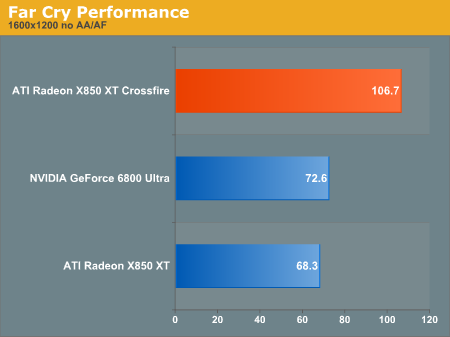
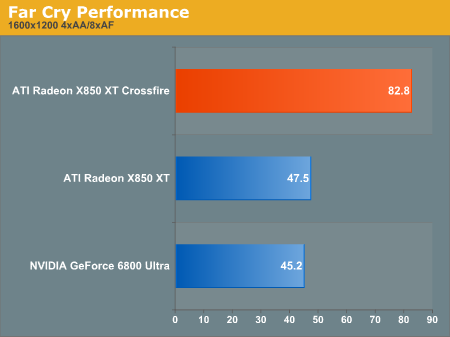
Half Life 2 Performance
This is one of those games that CrossFire will be able to push beyond 1600x1200 with ease. The performance numbers that we see here put ATI's solution in a much better position than NVIDIA's 6800 Ultra SLI. In this case, the x850 CrossFire even competes with the 7800 SLI solution as they both reach near the CPU limit of the system at 1600x1200.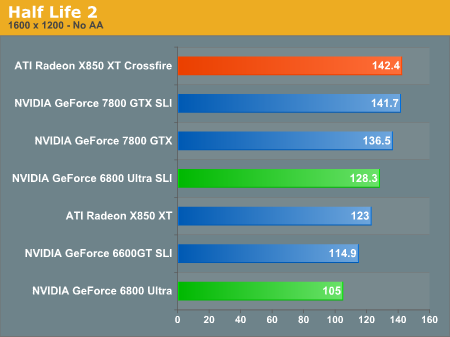

Splinter Cell: Chaos Theory Performance
Again, the X850 falls between the 7800 GTX and 7800 GTX SLI solutions. The 6800 Ultra SLI setup lags behind compared to CrossFire in this benchmark. The disadvantage here is that CrossFire users won't be able to turn on some of the more detailed shaders (which happen to use SM3.0).It's very clear that CrossFire competes well from a performance standpoint. But when it comes to feature set, NVIDIA still has ATI beat. The SM3.0 options do make a visual difference in SC:CT, and they're worth enabling if spare graphics power is sitting idle. We didn't run NVIDIA parts with SM3.0 because we like comparisons to be as "apples to apples" as possible.
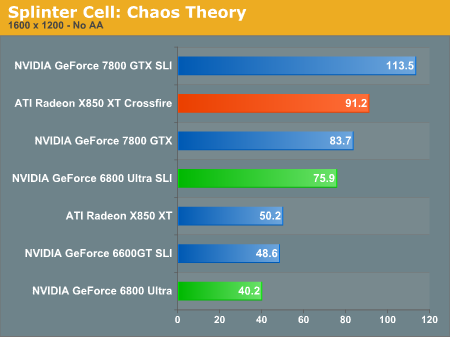
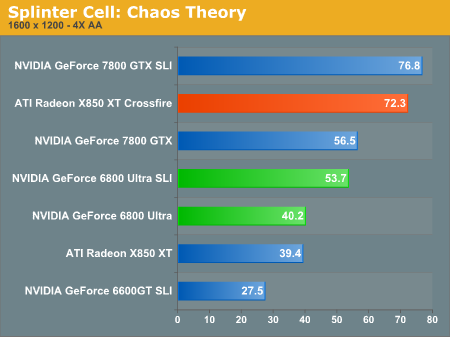
Unreal Tournament 2004 Performance
UT would also not run with AA enabled. The test that we were able to run is still somewhat CPU limited. These results are included, as when we see CPU limited games using CrossFire, they tend to score lower than other solutions. Our best guess is that this issue will be fixed as the CrossFire driver implementation is further finalized. It is likely driver overhead adding extra CPU requirements to the system. We have been told that performance numbers with this hardware and driver combo are mostly final, but we will have to wait and see.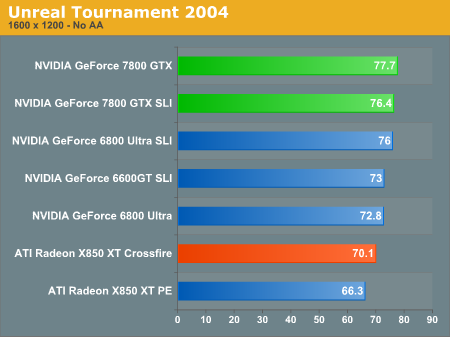
Final Words
So, what have we learned? CrossFire is a solid competitor to SLI at the high end. The hardware and drivers are far enough along to provide very good performance on quite a few titles. SuperTiling works using 32x32 blocks and doesn't seem to have any problems other than the odd glitch while changing modes. CrossFire AA modes don't work quite yet, but games will run and something near what should be there shows up.Gigabyte has stated that they not only have NVIDIA SLI working on their GA-K8AMVP Pro, but that dual 3D1 cards will work as well (with a modified BIOS and driver at the moment). We haven't had a chance yet to test this ourselves, but we will definitely have something up on the combination as soon as we can.
There are some downsides, however. While CrossFire often provides more performance than the 7800 GTX, we don't get the benefit of SM3.0, which is being used in more and more games. The added cost will either eat into your budget for a next generation card when they come along, or will usurp money that might be better spent on a monitor to handle very high resolutions. There are plenty of examples of CPU limited games at 1600x1200 using CrossFire (basically the same list as the 7800 GTX). As time goes on, it will be important to invest in a monitor or money spent on ultra high end graphics solutions will go to waste.
The bottom line is that CrossFire is a success in implementation. We are impressed with the performance of the solution, especially considering the very early hardware and software that we have our hands on here. When a final solution is released, we will be doing a much more in-depth performance and image quality analysis of the hardware, but at this point, we just want to get a solid idea about what to expect. And right now, we expect exciting things for ATI. To recap performance, we've put together a table showing improvement due to the addition of a second GPU under CrossFire and SLI.
| Multi GPU % Performance Improvement (16x12 noAA) | |||||
| Doom 3 | Everquest 2 | Half-Life 2 | Splinter Cell 3 | UT 2004 | |
| CrossFire | 42.9 | 2.3 | 11.1 | 82.3 | 5.7 |
| SLI | 34 | 1.4 | 22.2 | 88.8 | 4.4 |
| Multi GPU % Performance Improvement (16x12 4xAA) | |||
| Doom 3 | Half-Life 2 | Splinter Cell 3 | |
| CrossFire | 70.6 | 29.9 | 83.8 |
| SLI | 81.3 | 68.2 | 33.6 |
Clearly, even in it's early stages, CrossFire can bring some good competition to SLI.
If ATI can get their chipset out there alongside CrossFire master cards, we could see some good adoption. Their new chipsets are no slouches (well, maybe the southbridge is a little lacking). What is very clear is that ATI needs to get a solution out as soon as possible. Time isn't standing still for ATI while the 7800 GTX is out with zero competition in a single slot.
Once again, we would very much like to thank Gigabyte for providing us with the hardware necessary to run these tests. We were very happy with the performance of their hardware, and will have a more in-depth look at the motherboard as soon as possible.







